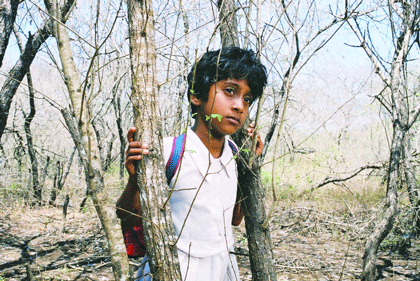Stunning Sri Lankan debut evokes Tarkovsky
Being a guard must be one of the most boring jobs in existence. Anaru (Mahendra Perera), one of the main characters in Sri Lankan director Vimukthi Jayasundara’s “The Forsaken Land,” mans a remote outpost with gun in hand. He has little to do but watch and wait. As it turns out, that seems to be his entire country’s fate. Without becoming boring themselves, few films are so attuned to the rhythm of tedium and depression.
Jayasundara could have made a fascinating non-narrative film; his first third comes close to being a plotless collection of scenery. However, “The Forsaken Land” manages a fresh blend of formalism and humanism. It’s been a long time since I’ve seen such a stunning debut, especially from a filmmaker still in his 20s.
To a large extent, laying out the plot of “The Forsaken Land” betrays the experience of watching it, but it may be helpful to go into it having some idea what will happen. The film begins in the midst of a cease-fire between the Sri Lankan government and the Tamil Tigers. Nevertheless, the army is still everywhere. In a small village, Anaru lives with his wife Lata (Nilupili Jayawardena) and sister Soma (Kaushalya Fernando). He works as a guard in the daytime, sharing his post and gun with an older man, Piyasiri (Hemasiri Liyanage). When he’s at work, Lata conducts an affair with one of his friends. She’s jealous of Soma, who works in a nearby town. The village falls under a strange mood—not at war, but hardly peaceful. Then corpses start appearing.
I don’t want to romanticize Jayasundara as a Third World primitive—which he clearly isn’t—but a certain degree of isolation may have its benefits. A filmmaker working in New York or Paris is drowning in images of his or her city, while Sri Lankan villagers may be starved for images of theirs. Even so, if there’s any region “The Forsaken Land” shows any affinity with, it’s Eastern Europe, particularly the Russia of Andrei Tarkovsky. For all the intellectual aspirations of Tarkovsky’s “Stalker,” the film may be most valuable for introducing an uncanny shade of green, unlike any I’ve seen elsewhere in cinema or life. First and foremost, his films are sensual experiences—their spiritual and philosophical baggage comes later.
Jayasundara is even more inclined towards abstraction and reveling in nature’s beauty than Tarkovsky, but his tracking shots are similar. Almost every scene in “The Forsaken Land” is comprised of just one shot. Each one plays like a mini-feature, often ending in a surprising place.
Voyeurism is a running motif in “The Forsaken Land.” Several times, characters watch each other have sex. Jayasundara uses landscapes to express his characters’ point-of-view. At one point, he turns from a topless woman to the vast, arid field she surveys; at another, he cuts from a soldier’s rambling story about the excitement of flying while stoned to a shot of the sky. These sequences hint at a spiritual yearning that’s rarely fulfilled. The violence Anaru watches for does come, but not in the form one anticipates—the film’s torture and suicide scenes are more jarring than they might be in a bloodier film because they’re so sudden; it’s more concerned with long-term consequences than actions themselves.
“The Forsaken Land” synthesizes beauty and tension. The ever-present possibility of warfare prevents it from lapsing into mere nature-porn, as does the rigor of Jayasundara’s framing and camera movements. It shows the signs of a people scarred by violence while depicting an uneasy, half-hearted peace. Dialogue is minimal and mostly unimportant. There’s a clash between its avant-garde leanings and the demands of storytelling, with the former taking precedence. The plot is much easier to navigate on paper than onscreen.
This approach doesn’t always work to Jayasundara’s benefit, but one comes away with the impression that conventional narrative would betray the uniqueness of the experiences described in “The Forsaken Land.” It carries a sense of place as indelible as any Gabriel Garcia Marquez short story, perhaps all the more potent because one remembers the texture of wind and the color of grass as much as the characters.
“The Forsaken Land” is being presented at the American Museum of the Moving Image as the kickoff in a series of foreign films that would otherwise be hard to release theatrically. It’s hard to imagine a work whose politics are so oblique—and anti-war—angering Sri Lankans to the point where Jayasundara decided to move to France, but unfortunately, that’s the case.
The Berlin Film Festival’s message board is testimony to the seething hatred he’s somehow provoked. One wonders whether he’ll be able to continue working in his homeland, a “forsaken land” on the map of world cinema even for avid cinephiles. Made anywhere in the world, “The Forsaken Land” would be startlingly original; coming from Sri Lanka, it’s a bold testimony that the nation has a right to a voice of its own on film.
gaycitynews.com



































